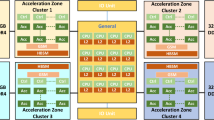Abstract
The revised simplex algorithm (RSA) is a typical algorithm for solving linear programming problems. Many theoretical modifications have been done to make the algorithm more efficient, but almost all of them were based on single-instruction single-data architecture processors (CPUs), which could not make full use of the inherent parallel characteristics of RSAs. We propose a novel single-instruction multiple-data architecture processor (GPU) based on the RSA in this paper. The intensive matrix manipulations of a traditional RSA are offloaded to the GPU, which helps to make full use of its powerful parallel processing ability. We implemented the GPU-based RSA on compute unified device architecture (CUDA). Numerical experiments on randomly generated linear programs show that the GPU-based RSA can not only find the correct optimal solutions, but can also reach a speed of up to 100 times as fast as that of a CPU-based RSA: it also runs 3 to 11 times as fast as MATLAB.









Similar content being viewed by others
References
Anderson JA, Lorenz CD, Travesset A (2008) General purpose molecular dynamics simulations fully implemented on graphics processing units. J Comput Phys 227(10):5342–5359
Belleman RG, Bédorf J, Zwart SFP (2008) High performance direct gravitational N-body simulations on graphics processing units II: an implementation in CUDA. New Astron 13(2):103–112
Belloch JA, Gonzalez A, Vidal AM, Cobos M (2015) On the performance of multi-GPU-based expert systems for acoustic localization involving massive microphone arrays. Expert Syst Appl 42(13):5607–5620
Demirel E, Demirel N, Gökçen H (2016) A mixed integer linear programming model to optimize reverse logistics activities of end-of-life vehicles in Turkey. J Clean Prod 112:2101–2113
Douglas CC, Lee L, Yeung MC (2016) Hierarchical density-based clustering based on GPU accelerated data indexing strategy. Procedia Comput Sci 80:951–961
Ezzati R, Khorram E, Enayati R (2015) A new algorithm to solve fully fuzzy linear programming problems using the MOLP problem. Appl Math Model 39(12):3183–3193
Fu Z, Ren K, Shu J, et al. (2015) Enabling personalized search over encrypted outsourced data with efficiency improvement
Gobron S, Devillard F, Heit B (2007) Retina simulation using cellular automata and GPU programming. Mach Vis Appl 18(6):331–342
Guastaroba G, Mansini R, Ogryczak W, Speranza MG (2016) Linear programming models based on omega ratio for the enhanced index tracking problem. Eur J Oper Res 251(3):938–956
Ho TY, Lam PM, Leung CS (2008) Parallelization of cellular neural networks on GPU. Pattern Recogn 41(8):2684–2692
Huangfu Q, Hall JAJ (2015) Novel update techniques for the revised simplex method. Comput Optim Appl 60(3):587–608
Jermain CL, Rowlands GE, Buhrman RA, Ralph DC (2016) GPU-accelerated micromagnetic simulations using cloud computing. J Magn Magn Mater 401:320–322
Junior HV, Lins MPE (2005) An improved initial basis for the simplex algorithm. Comput Oper Res 32(8):1983–1993
Leung CS, Wong TT, Lam PM et al (2006) An RBF-based compression method for image-based relighting. IEEE Trans Image Process 15(4):1031–1041
Liu W, Schmidt B, Voss G et al (2007) Streaming algorithms for biological sequence alignment on GPUs. IEEE Trans Parallel Distrib Syst 18(9):1270–1281
Liu W, Schmidt B, Voss G, et al. (2007) Molecular dynamics simulations on commodity GPUs with CUDA//International Conference on High-Performance Computing. Springer Berlin Heidelberg 185–196
Luh H, Tsaih R (2002) An efficient search direction for linear programming problems. Comput Oper Res 29(2):195–203
Marziale L, Richard GG, Roussev V (2007) Massive threading: using GPUs to increase the performance of digital forensics tools. Digit Investig 4:73–81
Oh KS, Jung K (2004) GPU implementation of neural networks. Pattern Recogn 37(6):1311–1314
Owens JD, Luebke D, Govindaraju N et al (2007) A survey of general-purpose computation on graphics hardware //computer graphics forum. Blackwell Publishing Ltd 26(1):80–113
Paparrizos K, Samaras N, Stephanides G (2003) A new efficient primal dual simplex algorithm. Comput Oper Res 30(9):1383–1399
Peercy M, Segal M, Gerstmann D. (2006) A performance-oriented data parallel virtual machine for GPUs//ACM SIGGRAPH 2006 Sketches. ACM. 184
Richter C, Schöps S, Clemens M. (2016) Multi-GPU Acceleration of Algebraic Multigrid Preconditioners//Scientific Computing in Electrical Engineering. Springer International Publishing. 83–90
Rocha P, Rodrigues R, Gomes A M, et al. (2015) GPU-Based Computing for Nesting Problems: The Importance of Sequences in Static Selection Approaches//Operations Research and Big Data. Springer International Publishing 195–202
Sanders J, Kandrot E. (2010) CUDA by example: an introduction to general-purpose GPU programming. Addison-Wesley Professional
URL: http://docs.nvidia.com/cuda/optimus-developer-guide/index.html, 2017
Xia Z, Wang X, Sun X, Wang Q (2016) A secure and dynamic multi-keyword ranked search scheme over encrypted cloud data. IEEE Trans Parallel Distrib Syst 27(2):340–352
Yang X, Pi X, Zeng L, et al. (2005) GPU-based real-time simulation and rendering of unbounded ocean surface//Ninth International Conference on Computer Aided Design and Computer Graphics (CAD-CG'05). IEEE. 6 pp
Zhangjie F, Xingming S, Qi L et al (2015) Achieving efficient cloud search services: multi-keyword ranked search over encrypted cloud data supporting parallel computing. IEICE Trans Commun 98(1):190–200
Zhong Z, Feng M, Liu D (2015) Parallelization of revised simplex algorithm on GPUs //network and information Systems for Computers (ICNISC), 2015 international conference on. IEEE. 349–353
Acknowledgements
This work was supported in part by the National Natural Science Foundation of China (51679105, 61672261,51409117), Jilin Province Department of Education Thirteen Five science and technology research projects [2016] No. 432, [2017] No.JJKH20170804KJ.
Author information
Authors and Affiliations
Corresponding authors
Rights and permissions
About this article
Cite this article
He, L., Bai, H., Jiang, Y. et al. Revised simplex algorithm for linear programming on GPUs with CUDA. Multimed Tools Appl 77, 30035–30050 (2018). https://doi.org/10.1007/s11042-018-5947-z
Received:
Revised:
Accepted:
Published:
Issue Date:
DOI: https://doi.org/10.1007/s11042-018-5947-z




